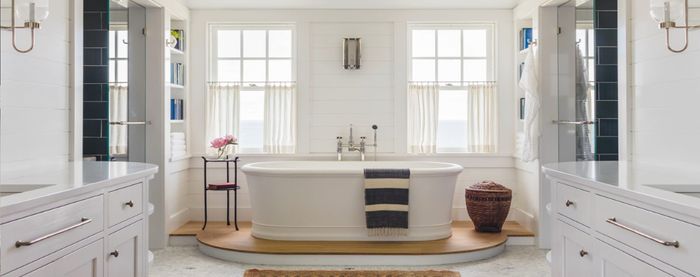Build a Floating Vanity: Tips for Installing Drawer Slides and Cabinet Hinges
Learn how to use jigs to align cabinet drawer and door hardware, and see a trick for getting screws to grab better in MDF doors.
A floating vanity is an engineering challenge. It doesn’t have legs and must be supported only by the wall. The connection between the wall and cabinets must be rock solid, and more importantly, the cabinets must be strong enough to support themselves, support the counter, and resist racking. In the following Master Carpenter video series, veteran cabinetmaker Nancy Hiller demonstrates how she assembled the cases, built drawers, strategized the façade, and figured out a great system of hardware to hang the vanity on the wall.
In this bonus episode, Nancy shows us step-by-step how to install door and drawer hardware to make her cabinets open and close perfectly. Watch for some great tricks to make this part of any cabinet project go more smoothly.
All Videos in This Series:
1. Introduction
4. Cut and Finish Doors and Drawer Faces
6. Bonus Video: Tips for installing hinges and drawer slides
| Read the companion article: | View more videos: |








View Comments
The drawer slides are from Blum (as in plum) rather than Blum (as in bloom). Otherwise, great job Nancy.
So, if the installed drawers with easy close slides are "sticky", and were installed level and parallel,and presuming the side-to-side distance is not too small, would you use washers underneath the slides at the screws to reduce the side-to-side distance?
In this part of the world, we pronounce Blum as "bloom". Same way Nancy says it.
Great videos, Nancy.
It is Bloom -like in the springtime.
very nice series - thx
Enjoyed the series, nicely done!
Positively medieval.....
I haven't followed those instructions for almost 30 years.
Hettich has a fantastic 32 mm. jig that eliminates all but the most rudimentary
measurements. I cut my gables from the initial calculations & do not measure a
single thing after that. If your going to use European hardware you have to jump
in with....both feet ( pardon the pun )
Hardware is best installed before the cabinets are assembled.
When done properly, it's as easy as assembling as Ikea furniture but built to a
significantly higher level.
I taught many cabinet shops in my area & college students at our community
college the same techniques. Their furniture was finished better
( before assembly ) looked more professional, all within days of a short tutorial.
These video will really prove to be helpful in installing cabinets in my kitchen and will save my lot of money also.
I think I'm in love
Hate European hardware. If you're going to use them stick with the biggest name--Blum.
Ever tried to replace a wornout hinge in your kitchen cabinets? (metal dust on the shelves of the cabinets) They all look "kinda" the same, but actually each manufacturer's hardware is different, and with many different variations from each manufacturer. Yes, spend time finding the N.A. rep for the manufacturer, and discover that they no longer sell in the N.A market. ...but you can still get the hinge from a company that bought out the remaining stock---for $30 per hinge, plus shipping.
Oh, did I mention "private label" hinges that were stamped with Canac kitchens? Who made those hinges now that Canac is out of business?